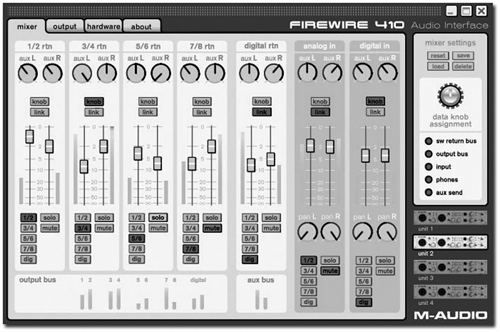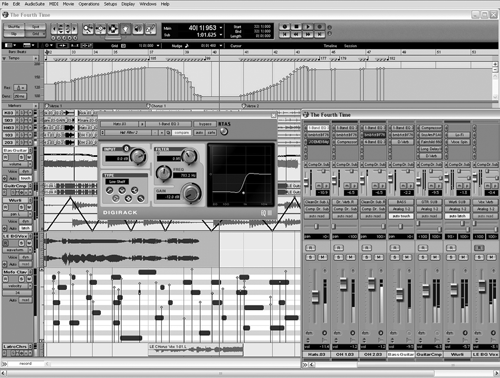Next to the input controls on the front panel is a stepped rotary control labeled Level Controller, which can adjust the output level of any of the eight outputs, using the 410 software control panel. Atop this knob are eight output signal level LEDs that flash yellow when signal is present at each analog output jack.
Next to these are twin stereo headphone outputs, each with its own rotary level control (both jacks carry the same signal, but I still think that having two headphone outs is very kewl). The rightmost section of the front panel contains S/PDIF in and out signal indicators, a MIDI Thru switch, a switch and indicator for the global phantom power, and a power switch.
This power switch has an associated blue LED which also provides status information. Fast flashing indicates that the Firewire firmware isn’t loaded, which can happen during the boot up process or when something has gone wrong between the computer and the 410. Slow flashing shows that the 410 has been detected by the computer, but that it isn’t yet switched on. A steady blue glow indicates that everything is hunky-dorey.
The rear panel contains the two aforementioned line input jacks, along with eight line output jacks (all of which are unbalanced quarter-inch jacks at -10dBV level), a pair of RCA and Toslink optical jacks for the S/PDIF ins and outs, two Firewire connectors, MIDI In and Out jacks, and a jack for the supplied but optional 12V DC power supply. The Firewire 410 is powered by the Firewire connection itself, except with some PC Firewire cards and with any 4-pin Firewire cables like those found on camcorders. The 12V supply is unnecessary with Macs.
All the audio inputs and outputs can operate at either 16 or 24-bits, and at up to 96kHz sampling rates. In addition, analog outputs 1 and 2 can playback at 192kHz (although I’m not quite sure why that’s important, unless it’s for compatibility with something or other).

DRIVERS AND PANELS
On the PC, the FW410 runs under Windows 2000 and XP (but not under Windows 98 or Me). On the Macintosh, you’ll need Mac OS 9.2 or later, or OS 10.1.5 or later. Mind you, those requirements are for the interface only, as Pro Tools M-Powered requires Windows XP or Macintosh OSX. As always, I disregarded the supplied driver CD-ROM and went straight to M-Audio’s web site to download the latest drivers. It’s important to do this since often the enclosed CDs are several months (and revisions) out of date. Be sure you get the right installer for your computer and software version... the FW 410 supports ASIO2 and WDM on the Windows side, and Core Audio on the Mac side.
Whatever your computer platform, you must run the FW410 installer program before plugging in the Firewire 410 itself, so that the various files needed by the interface are loaded on boot up. Following the driver installation, the installer forces you to reboot your computer, but don’t plug in the FW410 with your computer running — M-Audio warns in several places against “hot-plugging” the Firewire 410, lest you toast the Firewire ports either on the interface (a real drag) or on your computer (a disaster that may require the motherboard be replaced). So run the installer, and shut down the computer... now you can plug in the 410, power it up, and have the new hardware properly detected on startup.
M-Audio’s Control Panel software for the Firewire 410 is useful when using the interface with programs other than Pro Tools M-Powered. It has four main pages labeled Mixer, Output, Hardware and About. The last of these simply provides details of software and hardware versions, covering driver and panel software, boot loader, firmware and hardware.
The Mixer page provides separate control over all 10 of the playback channels (eight analog and two digital), plus the four inputs (two analog and two digital), arranged in stereo pairs. Each channel has level faders, along with peak-reading meters, Link buttons for stereo fader control, Solo and Mute buttons, and there are routing options to assign channels to hardware inputs, although you will want to make changes from within your audio program.
The Output page lets you reconfigure the channel outputs to other than the default hardware outputs, but again you’ll probably want to make these changes from within your audio editor. The most useful function of the Output page is to let you assign the stereo headphones to outputs other than the default channels 1/2. The Hardware page lets you set sample rate, the ASIO/WDM buffer size from 64 to 2048 samples (with a default value of 256), the selection of internal or external sync source, and selection of optical or co-axial S/PDIF input signal. By the way, both digital outputs carry exactly the same signal.

